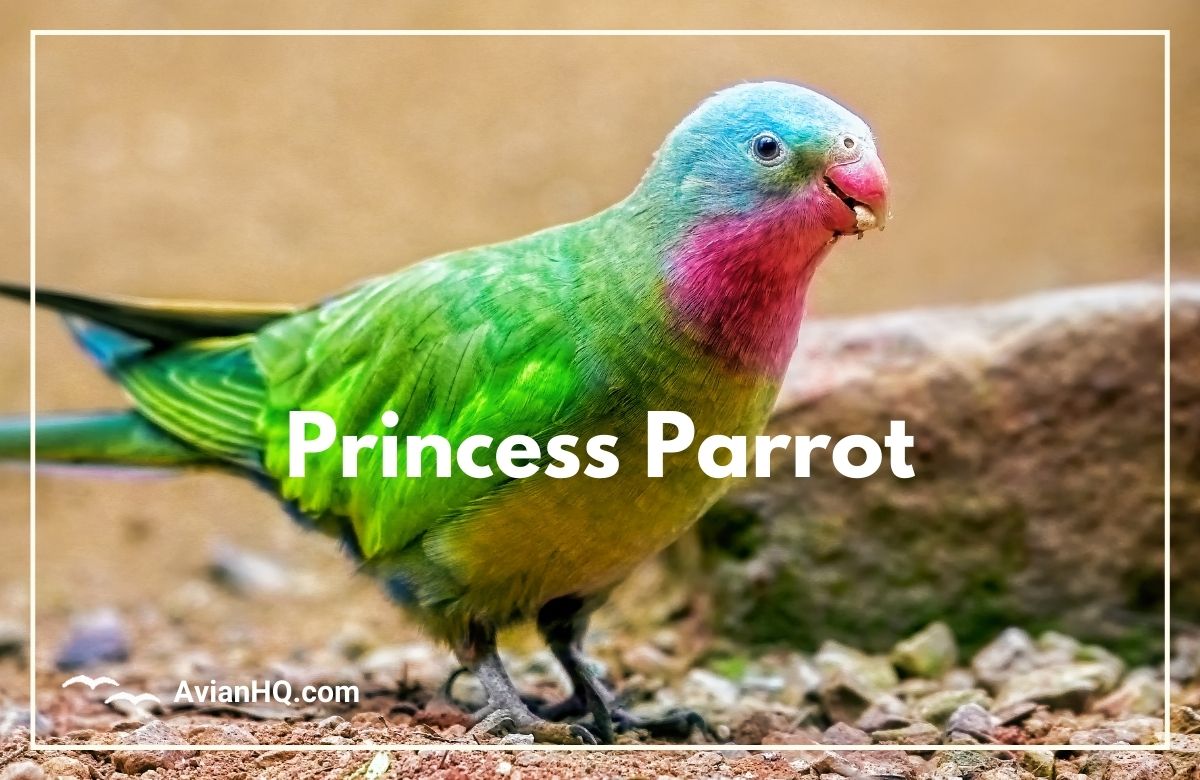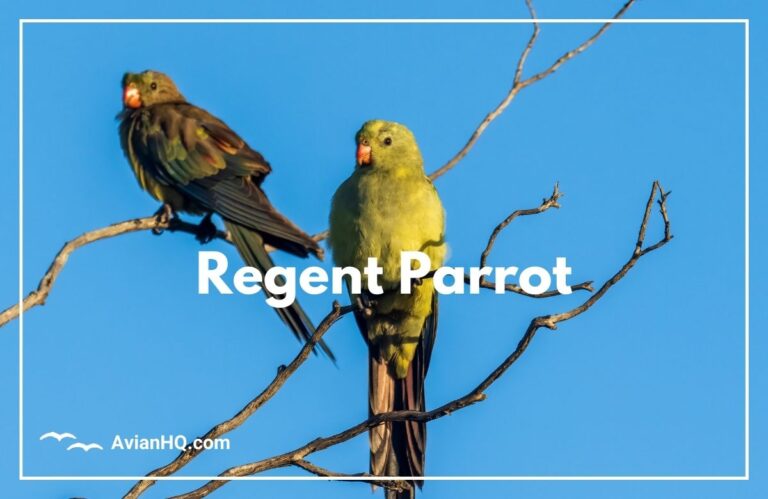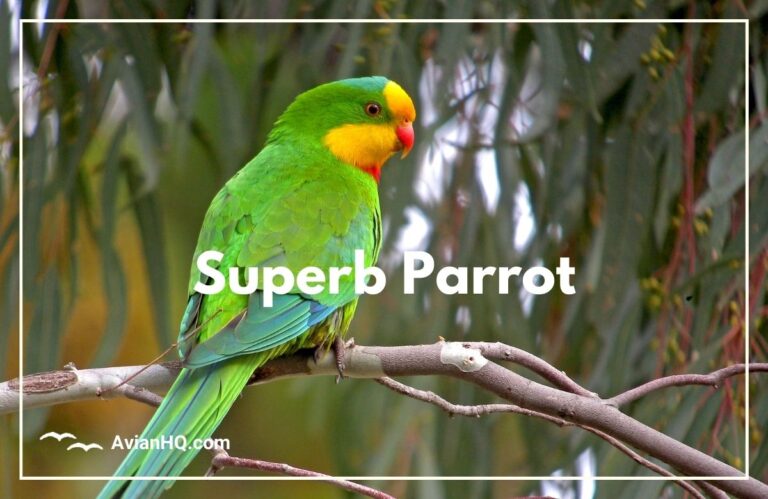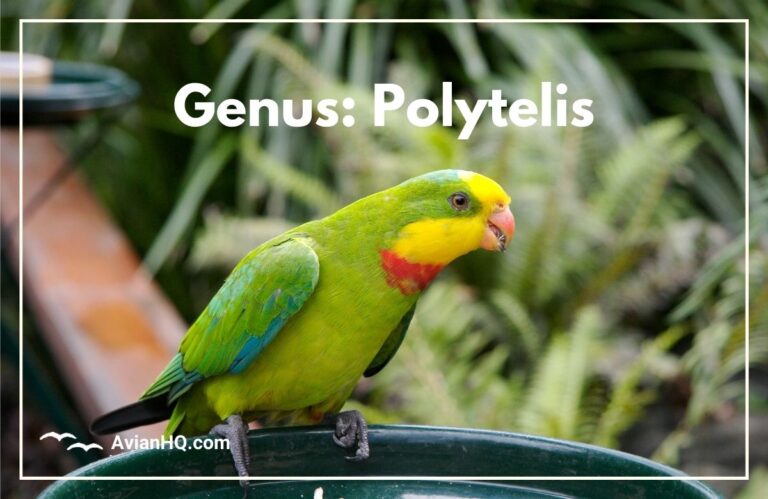Princess Parrot (Polytelis alexandrae)
As you explore Australia’s vast and arid interior, a flash of colorful plumage may alert you to the presence of the Princess Parrot (Polytelis alexandrae). This medium-sized parrot measures 13 to 18 inches (34 to 46 cm) long and weighs between 4 to 5 ounces (110 to 120 grams). It’s vibrant hues stand out against the red sands and sparse vegetation of it’s outback habitat.
The Princess Parrot’s plumage dazzles with a palate of green, blue, pink, and coral. The crown and rump offer a regal dash of bluish-purple, while the shoulders gleam bright green. The namesake pink throat trails down the neck into a rose-hued breast band. The tail feathers display green edged with pink, and mature males sport a brilliant coral-red beak.
As the table below summarizes, females and juveniles showcase more modest versions of this resplendent color scheme:
| Plumage Area | Male Color | Female/Juvenile Color |
|---|---|---|
| Crown | Blue | Dull gray |
| Throat | Vibrant pink | Paler pink |
| Shoulders | Bright green | Olive green |
| Beak | Coral red | Brownish pink |
First described by acclaimed ornithologist John Gould in 1883, the Princess Parrot’s name pays tribute to Alexandra of Denmark, Princess of Wales. This magnificent desert dweller has also been called the Spinifex Parrot for it’s affinity to that dryland grass. It’s scientific name Polytelis derives from Greek, meaning “many spotted,” an apt label for this patchwork of polarized hues.
As you track this elusive nomad across Australia’s vast interior, appreciate the role it’s contrasting colors likely play in survival. They may help camouflage the parrot within the scattered foliage and red sands of it’s habitat. The warning pinks and reds could also signal toxicity, deterring potential predators.
While a chance sighting of the Princess Parrot makes a treasured memory for any birder, population declines and habitat loss necessitate increased protections for this extraordinary species. Read on to learn more about the natural history, ecology, and conservation challenges facing this vivid icon of the Australian outback.
History and Taxonomy of the Mysterious Princess
The vibrant beauty of the Princess Parrot captivated John Gould, who officially described the species for science in 1883. Gould bestowed the regal moniker in honor of Alexandra of Denmark, Princess of Wales from 1863 and eventually Queen Consort of the United Kingdom.
Gould collected the first specimen in 1864 during an expedition to Australia’s interior. Additional early records documented the species in parts of Western Australia and the Northern Territory. But the Princess Parrot’s nomadic ways and preference for remote deserts kept it veiled in mystery for decades.
Not until the 1950s and early 1960s did a series of systematic surveys begin to shed more light on the habitat, diet, and habits of these colorful recluses. The 1962 Central Australian Expedition stands as one of the most intensive investigations into the Princess Parrot to date. Yet even today, many details of it’s natural history remain scarcely documented.
The species’ scientific name Polytelis alexandrae places it in the genus Polytelis, derived from Greek meaning “many spotted.” This genus contains three Australian parrots, all slim, long-tailed forms that inhabit dry inland areas.
The Princess Parrot’s two close relatives are the Superb Parrot (P. swainsonii), distinguished by a sunset-colored face and throat, and the Regent Parrot (P. anthopeplus), boldly patterned in red, yellow and navy blue.
While several color variants of the Princess Parrot exist in aviculture, no differentiated subspecies have been defined within it’s native range across Australia’s remote outback expanses.
So while taxonomy reveals it’s nearest kin, much of this captivating bird’s natural pedigree remains cloaked in the mysteries of Australia’s desert isolation. Tracking down these rare green-and-pink jewels for even a fleeting glimpse is an unforgettable privilege for intrepid birders.
Dazzling Colors and Subtle Signs of a True Princess
The vibrant paintbrush of colors decorating the Princess Parrot gives it an unmistakable flair. Measuring 13 to 18 inches (34 to 46 cm) long with a slender, elongated tail, a visual feast of contrasting hues wraps this parrot in regal style.
Vivid greens cloak the wings and mantle, while bright pinks splash across the forehead, cheeks, throat and breast. Splashes of purple-blue adorn the crown, nape and rump. Mature males showcase a coral red beak, and orange eyes gleam below bluish foreheads.
Females and juveniles share the same elegant pattern but in more subdued tones. Their green upperparts wash into gray, the pink fades towards beige, the reds dull to brownish-orange. But the most telling sign is their relatively shorter tail and it’s less dramatic tapering shape.
The male’s tail reaches up to 18 inches (46 cm) long, the outer feathers narrowly streaming back nearly twice the length of the inner ones. This elongated, graduated form likely aids aerodynamic agility in flight.
Mature males also grow distinctive spatule-shaped extensions projecting sideways from the tip of the third primary feathers on each wing. These “spatules” resemble mini paddle shapes. Their function is uncertain, but may help produce unique sounds during flight.
So when a passing blur of green-and-pink catches your eye, examine those tail feathers and wing tips for clues. If spread like streaming banners behind a elongated tail, you’re in luck – it’s a male Princess in all his royal grandeur!
Subtle signs like longer tails and specialized wing feathers separate the noble princes from the ladies-in-waiting. But the dazzling colors of both sexes announce this parrot as Australia’s most majestic inland bird.
Remote Haunts Across Australia’s Outback Wilderness
The arid expanses of Australia’s remote interior provide the primary stronghold for Princess Parrots. Their range spreads across much of Western Australia, the Northern Territory, and western Queensland.
Though scarcely documented, small numbers may reach as far east as northwestern New South Wales. Most records have occurred in Western Australia’s Goldfields and deserts near the South Australia border. Parts of the Great Victoria Desert and Gibson Desert host the species as well.
Princess Parrots frequent some of Australia’s most inhospitable wilderness. Far from coastal rains, the red center of the continent bakes under severe heat and drought. Vegetation withers across scrublands and hummock grasslands dotted with desert oaks and small eucalypt woodlands.
Here the parrots forage in isolated pockets of spinifex grasses, acacias, and other hardy shrubs eking out an existence in dried riverbeds or sandy plains. In heatmap summers, surface temperatures soar well above 100°F (38°C), while nighttime lows routinely plummet below freezing in winter.
Yet despite this parched and punishing interior, Princess Parrots manage to scrape out a living their whole lives without ever needing to drink. The water content of their specialized desert seeds and plant foods provides all the moisture they require, even breeding successfully through intense droughts.
These extreme conditions form critical environmental cues for the species. Their movements follow the sporadic blooming of seed-bearing flowers and grasses after rare desert rains. With no surface water available, the parrots neither bathe nor swim. Dust baths suffice to clean their colorful plumage.
Thanks to it’s impenetrable isolation, lack of permanent surface water, and paucity of food plants, Australia’s arid outback affords the Princess Parrots refuge through sheer inhospitality. Few predators or competitors penetrate so deep into these remote sanctuaries.
But increasingly, human developments impinge on even these far-flung havens. As miners tap rich veins buried in the ancient land and pastoralists seek forage for livestock, the question remains whether Princess Parrots can continue thriving in their shrinking domain.
Foraging Far and Wide for Desert Bounty
Life in Australia’s arid zone demands both opportunism and ingenuity, traits the Princess Parrot exhibits in it’s diet and feeding habits. As nomads traversing vast stretches of interior scrubland, finding scattered sources of nutrition is a daily challenge.
Their primary sustenance comes from the small, hard seeds of spinifex, porcupine grass, and other resilient desert plants. The parrots supplement these with leafy greens, flower blossoms, and the occasional insect snack.
Spinifex produces copious amounts of protein- and carb-rich seeds perfectly tailored to desert survival. In fact, each two-ounce (50 g) yield from a single spinifex hummock contains enough calories to support parrots through the hot months when other plants lie dormant.
To extract their bounty, the parrots cling to stalks and stems with their strongly curved beaks and dexterous feet. They nibble grass heads, probe flowers, and harvest ripe seed clusters. Both male and female share equally in foraging duties. When bountiful bonanzas emerge after scarce desert rains, up to a hundred parrots may congregate on prosperous patches.
Despite the isolated nature of food and water sources, Princess Parrots log an impressive amount of ground coverage while feeding. In a single day, these parakeets readily range over 6 miles (10 km), and daily home ranges span areas of several dozen square miles (over 100 square km).
Their ability to target widely scattered hotspots of productivity enables the species to breed successfully despite constantly fluctuating food supplies. It also underscores why protecting vast tracts of intact habitat remains vital to preserving Australia’s desert dwellers. Fragmentation that destroys native vegetation or isolates critical feeding areas threatens the survival of wide-roaming species like these colorful nomads.
Both their beauty and their resilience make Princess Parrots special ambassadors for the unique biodiversity in Australia’s remote outback. These intrepid travelers linger always on the edge of mystery and captivate all who cross their path, however briefly.
Raising Royalty: From Eggs to Fledglings
The remote and sporadic nesting habits of Princess Parrots means few direct observations exist of wild pairs breeding. But piecing together data from nest inspections, captive studies, and anecdotal reports gives some insight into how they raise the next generation of desert dwellers.
Princess Parrots typically nest in tree hollows, favoring holes in large eucalyptus and desert oaks. Rare ground-level nests may occur under the shelter of overhanging rocks or a spinifex hummock.
Nesting appears timed to periods of bounty, when rains transform arid zones into floral banquets. Pairs choose nest sites within roughly 12 miles (20 km) of productive feeding grounds to provision demanding hatchlings.
Clutch size is small, with wild pairs laying just 4 to 6 eggs. But the female may replace eggs that fail, allowing multiple attempts per season. The eggs measure about 1 inch (27 mm) long, their rounded shape a glossy white.
In captivity, only the female incubates eggs, spending long sessions curled in the nest while the male regularly brings food. Incubation lasts 19 days before naked, helpless chicks emerge.
These tiny hatchlings weigh only 0.2 ounces (6 grams) but grow phenomenally fast as both parents collect seeds, fruits and insects to feed the young. Eyes open by 6 days and feathers begin emerging within 2 weeks.
By 5 weeks age, those stunning colors are already brightening juvenile plumage. Chicks stand ready to test out clumsy first flights by this point. But another week or two is typically needed to build strength and agility for the critical first solo flight out of the nest hollow.
The long period of 35 days spent maturing in the nest represents an immense physical strain on parents provisioning the fast-developing chicks. It likely limits clutch sizes in the wild. However, it also equips the young with better odds of surviving once they fledge into the harsh outback.
Watching the next generation of vivid hatchlings grow from helpless fuzzballs into dazzling fledglings is reason enough for researchers to brave sweltering deserts. For those lucky enough to stumble onto an active nest hollow, it offers a rare glimpse into the private world of Australia’s most flamboyant parrots.
Nomadic Wanderers of the Lonely Desert
The remote haunts of Princess Parrots make observing their behavior a challenge, but a few key habits define their arid land ecology. These parrots are highly nomadic, wandering widely across Australia’s deserts in search of sporadic blooms of grass seeds and flowers.
Their movements follow no set seasonal pattern, dictated instead by the unpredictable rainfall patterns of interior Australia. Small flocks appear suddenly when brief wet spells trigger crop explosions, then vanish just as quickly.
Groups range from pairs up to about 15 birds, likely representing family units. They communicate with a wide repertoire of harsh calls, chattering alerts, and chuckling contact notes. These vocalizations help maintain bonds between flock mates traversing large areas.
Princess Parrots spend about half their day actively foraging, investigating potential food sources by digging in the soil and probing flowers. The remainder of daylight hours is spent resting while sheltering under trees or scrubs.
Once night descends, the parrots become quiet and still to conserve energy. They tuck their slender builds into a dense clump of vegetation, camouflaged by their mottled green, pink and blue plumage.
This habit of roosting communally even through frigid desert nights offers important heat savings. Huddling close with flock-mates reduces chilling night winds. It also allows the parrots to take turns on the colder outer perches, rotating position to share exposure.
When threats loom, Princess Parrots display a unique cooperative defense behavior dubbed “mobbing.” They gather to swarm much larger intruders such as monitors, dingos, or humans. Flying aggressively around the startled predator, their bright contrasting colors and loud shrieking calls may startle it into retreat. This mob patrol likely helps reduce losses to their small, vulnerable flocks.
So while their elegantly streamlined build suits these parrots for rapid long-distance flight, cooperative habits lend strength in numbers. By sharing vigilance duties, foraging info, and warmth, the social bonds of the flock help Princess Parrots pinpoint prosperity and deter disaster even in Australia’s most hostile desert extremes.
Precarious Future for Australia’s Desert Jewel
The radiant colors and remote range of the Princess Parrot capture public imagination, but closely tracking the species’ status poses challenges. As nomads wandering vast wilderness, populations dynamite erratically in response to irregular desert rains.
Comprehensive surveys across the parrot’s arid habitat are logistically daunting. Records rely predominantly on chance sightings, yielding fragmented distribution data. The last systematic assessment stems from an intensive 1982-83 field study.
Conservation groups thus face difficulties determining accurate population sizes or trends. Currently the IUCN Red List categorizes Princess Parrots as Near Threatened, with an estimated global population ranging between 2,500 – 10,000 mature individuals.
Evidence suggests the species is declining gradually but steadily. However proof remains sparse, lending urgency for updated nationwide monitoring efforts. Major threats include overgrazing by livestock, predation by invasive foxes and cats, and habitat degradation from changing fire regimes and mineral exploration.
Expanding human infrastructure fragments once-continuous desert, while pastoral stations displace native vegetation with introduced crop grasses. The vicious 2016 heatwave across Australia likely also took a further toll.
Princess Parrots occur across some protected wilderness reserves. But securing connectivity corridors to link isolated groups is vital for their nomadic lifestyles. Achieving stability for these specialized desert dwellers ultimately relies on preserving intricate ecological relationships across Australia’s vast arid center.
Glimpsing vibrant flashes of pink and green brightening barren plains should rouse appreciation for Australia’s iconic wildlife. But beyond admiring their elegance, increased stewarding is needed to ensure the outback remains a realm where royalty can thrive.
The future of the Princess Parrot spotlights a key question – whether Australia’s human populace recognizes the value of fragile desert ecosystems before remnant beauty vanishes from the heart of the continent.
Icon of Australia’s Desert Wilderness
The radiant beauty of the Princess Parrot has captivated people since it’s discovery. It’s colorful plumage and majestic moniker link it to royalty, while the remote habitat it inhabits imbues an aura of desert mystery.
This exotic allure has made the parrot a highly coveted species in the aviculture trade. Catching wild birds for captivity remains illegal, but captive breeding programs provide an alternative, if controversial, avenue to enjoy their company.
While keeping native birds as pets raises conservation concerns, Australia’s long fascination with aviculture helps connect people to wildlife. Princess Parrots are rated one of the top five most popular parrot species kept in households and breeding facilities.
Beyond the demand for their dazzling looks as pets or show birds, Princess Parrots have also come to symbolize the strange beauty of Australia’s arid outback. Their bright colors and elusive habits paint them as icons of the red center’s inaccessibility and extremes.
Features in tourism brochures as a signature desert species promote public awareness and appreciation of native biodiversity. Coinage, postage stamps, logos, and other national emblems have all depicted Princess Parrots as ambassadors of the country’s unique ecology.
This charismatic role aids efforts rallying support for expanded habitat protections in remote areas that rarely receive public attention. While most Australians will never venture into corner country haunts where Princess Parrots roam, their iconic status brings these arid ecosystems into mainstream spotlight.
So whether they glimpse “spinnifex parrots” in the wild, cross paths in captivity, or spot colorful form in art and advertising, Australians connect deeply to this radiant species endemic to their continent.
The favor owed these prominent icons reaches beyond simply admiring their beauty. It demands actively preserving the home where Australian royalty resides in the heart of the outback wild.
Conclusion
Few birds represent the mystique of Australia’s arid interior like the vivid Princess Parrot. As captivating nomads wandering an unrelenting landscape, they persist on the edge where scattered resources meet adaptive ingenuity.
The species’ dazzling contrast of greens, pinks, and blues offers more than aesthetic marvel. Their warning colors likely declare toxicity, while camouflage helps the parrots merge into the scrubby outback vegetation.
Form streamlines function as well. The male’s elongated tail and specialized wing feathers equip him for virtuosic flight to impress watching females. Drabber hues in the females remain better hidden during nesting duties.
Yet beyond intriguing details of the Princess Parrot’s natural history, broader questions loom over the future of Australia’s desert dwellers. Remote as their habitat may be, human impacts have already degraded vast tracts. Without connectivity across the intact spinifex plains and eucalypt woodlands of the red center, the parrots cannot continue their far-wandering ways.
In the generation ahead, Australians face the challenge of achieving balance between development interests and preservation priorities across arid regions relatively devalued. But for quintessential species like the Princess Parrot, the outback remains priceless wild country.
These vivid flagship species lend voice to whole ecosystems easily overlooked. Where they flourish, an intricate web of desert life still breathes. By ensuring the spinnifex blooms, the waterways flow, and the hollows shelter parrot royalty into the future, Australia upholds the evolutionary majesty written across it’s heartlands in seeds and feathers aglow.




